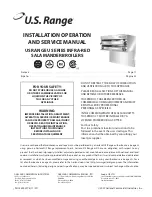
Tft Series Installation and Operation Instructions
│
Trinity
43
Air Removal
– The boiler and system plumbing layout must be configured to promote the removal of air from
the water. Air vents and bleeders must be strategically placed throughout the system to aid in purging the air
from the system during commissioning of the boiler. The system must also employ the use of a strategically
located air removal device, such as an air scoop or micro-bubbler, designed to remove the air from the water
as it flows through the system.
Follow the installation instructions included with the air removal device when placing it
in the system; air removal devices generally work better when placed higher in the
system. Always locate air removal devices in areas of the system that have a guaranteed
positive pressure, e.g., in close proximity to the water fill and expansion tank.
Trinity boilers are supplied with an automatic air removal device to aid in the purging of
air from the boiler during the initial fill. Place this devise in the location indicated in
Figures 10-1 through 10-3.
Expansion Tank
– The expansion tank must be sized in accordance with the water volume of the system as well
as the firing rate of the appliance. It is important to locate the expansion tank, and make-up water fill, on the
inlet side of any circulator in the system, as doing so will guarantee the lowest pressure in the system will be
at least equal to the tank and make-up water pressure. See examples in Figures 10-5 and 10-6.
Ensure the expansion tank cannot become isolated from the boiler anytime the system is
operating. Failure to follow these instructions may result in discharge of the Pressure
Relief Valve may result in property damage or personal injury.
The installation of flow checks, motorized valves or other shutoff devices (other than for
the purpose of servicing) are not permitted between the location of the "Closely Spaced
Tees" and the expansion tank; see Figures 10-5 and 10-6.
Indirect Fired Water Heater
– When installed as per Figure 10-6, the indirect fired water heater is in series
with the boiler during a demand for DHW. Therefore, its head loss, along with the head loss of the boiler and
associated piping, must be considered when sizing the circulator.
Figure 10-5: Single System Circulator Configuration
- Often used in applications zoned with “Zone Valves”.
During a demand for central heat, the boiler energizes the System Circulator via the Central Heating (CH)
pump output (PUMP C). The System Circulator must be sized to provide adequate circulation throughout the
heating system. During a Domestic Hot Water (DHW) demand, the boiler de-energizes the System
Circulator (PUMP C) and energizes the DHW Circulator (Pump A). With this configuration the Boiler
Circulator is the only pump that causes flow through the boiler and it is powered during any demand via the
boiler pump output (PUMP B). This circulator must be sized according to Table 10-4.
The piping configuration described above requires the Central Heating system and DHW
system to be de-coupled from the “Primary Loop” via closely spaced tees (Figure 10-5).
Figure 10-6: Multiple System Circulator Configuration -
Often used in applications with “Zone Circulators”.
This configuration requires the installation of a check valve located at each circulator. During a central
heating demand the boiler energizes the Central Heat Circulator via the Central Heat pump output (PUMP C).
During a Domestic Hot Water (DHW) demand, the boiler de-energizes PUMP C and energizes the DHW
Circulator (Pump A). Both Pump A and C, used in this configuration, are responsible for water flow through
the boiler and must be sized according to Table 10-4. Pump output, PUMP B is not used in this configuration.
Figures 10-5 and 10-6 illustrate typical piping systems. These piping schematics do not
illustrate all of the required concepts and components required to have a proper
installation. Concepts not shown include: prevention of thermal-siphoning (heat traps),
isolation valves, drain and purge valves, etc. It is the responsibility of the installing
contractor and system designer to determine which system best meets the need of the
installation and to consider all aspects of a proper system design. Contractor
modifications to these instructions may be required, based upon existing piping and
system design.
















































